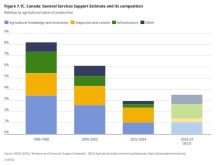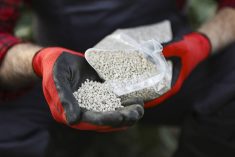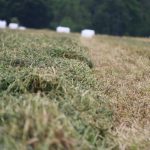Prices of fertilizer, which soared to record highs late this summer, are poised to come down to earth in coming months as sharply lower grain prices sour demand from farmers.
Meanwhile, tight credit markets and growing fears that a global recession may further dampen demand for commodities could add pressure.
“Purchasing and applications will be down (in the fall) – a result of crop price uncertainties and the lack of credit due to the financial crisis locking up the distribution chain,” Barrie Bain, director of fertilizer consultancy Fertecon Ltd., said in an e-mail.
Read Also

How much nitrogen can farmers really cut?
Manitoba fertilizer trials look for nitrification inhibitor sweet spot, to lower greenhouse gas emissions and cost without hurting yield.
Fertilizer prices skyrocketed earlier this year, when farmers bought more nitrogen, phosphate and potassium in an effort to maximize profits when corn, soybeans and wheat were all at or near record levels. But grain prices have since come down.
Chicago Board of Trade (CBOT) corn futures fell below $4 per bushel this month to the lowest level in a year after hitting almost $8 per bushel at the end of June. Soybeans hit a 14-month low last week, down 46 per cent from their record peak, while wheat touched a 16-month low, off 60 per cent from its record high (all figures US$).
The benchmark price for diammonium phosphate fertilizer (DAP) at the U. S. Gulf in New Orleans hit a record of more than $1,000 per ton in September, compared with about $400 a year earlier and around $220 two years ago.
Gulf DAP was at about $765 per ton the week of Oct. 20, and trade sources say prices were not expected to rise any time soon.
“Prices went straight up and now they are coming straight down. It’s just the market doing its job,” said Ken Johnson, editor of the weekly newsletter Midwest Fertilizer Insight.
Wholesale prices of anhydrous ammonia, another key nutrient, have also eased at the U. S. Gulf. After hitting a record of near $900 per ton in September, which was triple year-ago levels, prices fell to around $500 per ton last week.
But while wholesale prices have dri fted lower, trade sources said the retail prices farmers pay have yet to drop significantly. As a result, many farmers are taking a wait-and-see approach before making any additional nutrient purchases.
“If grain prices pick up before next spring – and for many crops, the fundamentals look good – we could see a strong spring and this will have an impact on fertilizer demand and prices,” Bain said. “If grain prices are low, (farmers) plant less and use less fertilizer.”














